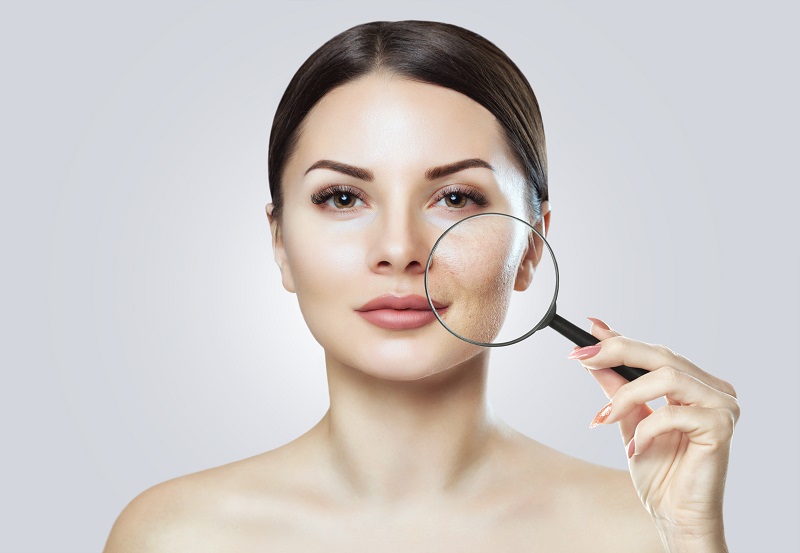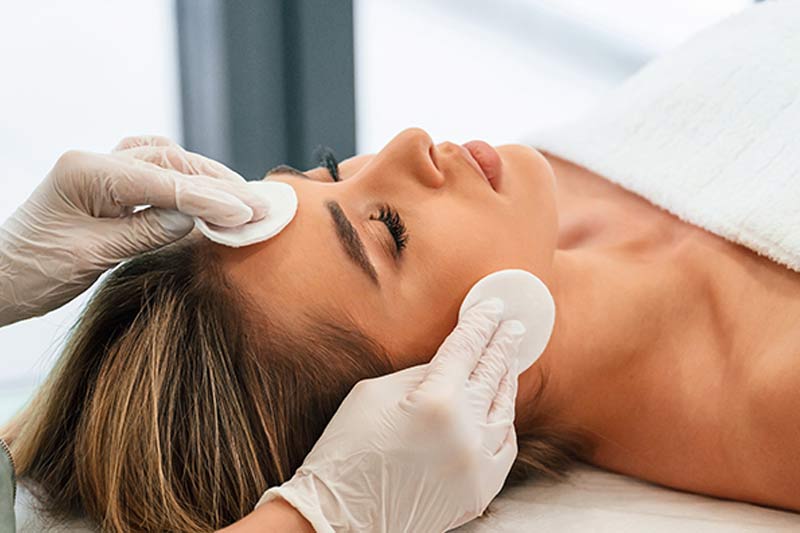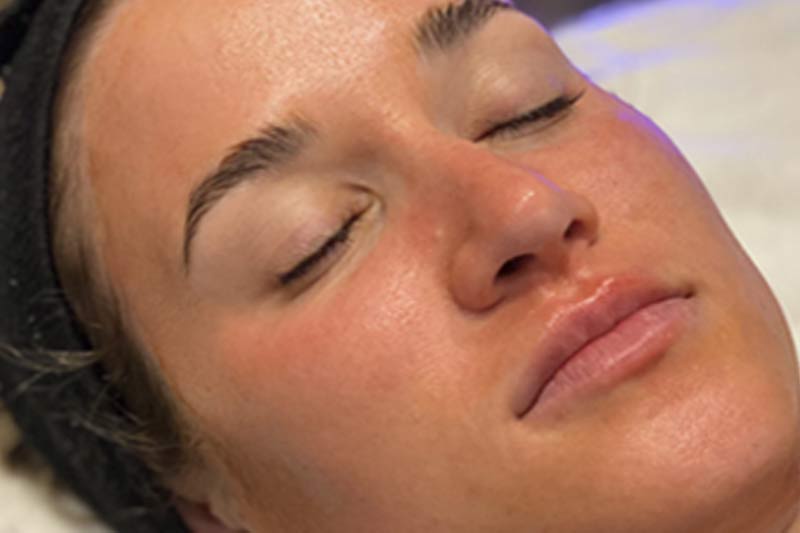A chemical peel is a skin resurfacing treatment that removes the skin’s top layer with chemical solutions and stimulates the body to grow rejuvenated skin.
Chemical peels are effective for acne scars because they stimulate collagen production and fill and even out scar tissue. The new skin is smoother and brighter, with fewer visible imperfections.
This article explores the best professional chemical peels for acne scars, gives recommendations for chemical peels for home use, and helps you choose the best treatment for your skin.

Which Chemical Peel Is the Best for Acne Scarring?
Professional chemical peels performed by an experienced medical provider can significantly reduce and, in some cases, eliminate acne scarring. The American Academy of Dermatology recognizes three major types of chemical peels: light or superficial, medium, and deep peels. Their strength and depth of penetration is based on their pH level, concentration of the active peeling agent, and the chemicals’ molecular size.
The treatment’s effectiveness for acne scars depends on the chemical peel type, the patient’s skin type, and the severity of scarring. Chemical peels are typically used for atrophic scars and post-inflammatory hyperpigmentation that often follows acne breakouts. They are not suitable for keloid and hypertrophic scars.
The following table presents the best chemical peels for different types of acne scars.
| Type of Acne Scars | Type of Peel | Chemical Solutions |
|---|---|---|
| Post-inflammatory hyperpigmentation and mild atrophic scars | Light (superficial) peels | AHAs and BHAs |
| Mild and moderate atrophic scars | Medium peels | TCA Glycolic acid Jessner’s solution |
| Deep atrophic scars | Deep peels | Carbolic acid (phenol) |
Light Peels
These peels are superficial, targeting only the epidermis or the outermost layer of the skin.
- pH – Their pH is higher, closer to 3.0 or above, making them less acidic.
- Concentration – They usually contain lower concentrations of milder acids.
- Molecular size – They often use larger-molecule acids like lactic acid or lower-concentration acids with smaller molecules, like glycolic acid.
AHAs in light peels include:
- Glycolic acid
- Lactic acid
- Mandelic acid
- Malic acid
- Tartaric acid
The most commonly used BHA in skin care is salicylic acid.
Light peels improve skin cell turnover and brighten the skin, reducing the appearance of mild acne scarring and post-inflammatory dark spots. Patients need a series of four to six treatments to see results.
Medium Peels
Medium peels penetrate the epidermis and reach the upper layer of the dermis, where they can address more significant skin issues and scars.
- pH – Lower pH, allowing for deeper penetration than a light peel.
- Concentration – A higher concentration of chemical solutions to penetrate deeper skin layers and stimulate collagen production. This helps fill atrophic scars and even out the skin’s surface.
- Molecular size – They often use a combination of different acids to achieve the desired depth, such as smaller-molecule glycolic acid along with TCA.
Common ingredients in medium peels include trichloroacetic acid (TCA), 60% glycolic acid, and Jessner’s solution (a combination of salicylic acid, lactic acid, and resorcinol).
Patients need at least 1-3 treatments to see results. The number of treatments depends on the severity of acne scarring.
Deep Peels
Deep peels penetrate into the midreticular dermis to treat severe skin damage and scars. They are the most invasive type of peel and require medical supervision.
- pH – Very low pH, making deep peels sufficiently acidic to cause a significant, controlled tissue injury.
- Concentration – The highest concentration of the most aggressive chemicals (e.g., a TCA concentration exceeding 50%).
- Molecular size – Deep peels use the strongest chemical agents to penetrate the deepest skin layers.
Phenol is the main peeling agent in deep peels. Sometimes, skincare professionals combine phenol with resorcinol or salicylic acid.
Deep peels visibly improve acne scarring, but they may not eliminate severe scars. The treatment requires sedation and weeks of downtime. Some experts recommend laser resurfacing instead, to avoid the long recovery period.
Key Ingredients in Professional Chemical Peels for Acne Scars

Professional chemical peels are stronger and more effective than at-home chemical solutions. They contain higher concentrations of active ingredients achieve more dramatic results. Professional peels can be very effective for acne scars, but they carry certain risks. It’s best to schedule a consultation with a licensed chemical peel provider. They will examine your skin and recommend a chemical peel which corresponds to your skin and acne scar type.
Mandelic Acid
Mandelic acid is an alpha-hydroxy acid commonly used for professional chemical peels. It is composed of large molecules that take time to penetrate the skin and rarely cause irritation. It is also less likely to cause discoloration and all skin types, including darker complexions, tolerate it well. Mandelic acid is often used in combination with salicylic acid.
Glycolic Acid (GA)
Glycolic acid is an effective exfoliating agent. It is another alpha-hydroxy acid but stronger than mandelic acid. It is commonly used in light and medium chemical peels. It stimulates collagen production and thickens the epidermis, helping to smooth atrophic scars. It also blocks melanin synthesis, reducing hyperpigmentation.
Glycolic acid is among the safer, less irritating chemical solutions. It is suitable for all skin types.
Lactic Acid (LA)
Lactic acid is among the mildest AHAs used to treat hyperpigmentation and acne scars. It is safe for dry and sensitive skin because it only penetrates the uppermost layer and doesn’t cause irritation. It is used alone or in combination with other chemical solutions for stronger effects.
Salicylic Acid (SA)
Salicylic acid is a beta-hydroxy acid commonly used in acne treatments to prevent pore clogging and fight acne-causing bacteria. It also effectively treats acne scars because it stimulates collagen production, which improves skin texture and reduces post-inflammatory scarring.
Salicylic acid is gentle and typically used for mild acne scars. Since it effectively reduces sebum and unclogs pores, skin experts usually recommend it for oily skin.
Azelaic Acid
Azelaic acid is neither an AHA nor a BHA, but a dicarboxylic acid. It has potent exfoliating, skin brightening, and anti-inflammatory properties. It can be combined with AHAs and salicylic acid to relieve post-acne redness and reduce the appearance of acne scars.
Kojic Acid
Kojic acid is a skin-lightening agent derived from fungi. It inhibits excess melanin production, which can occur in damaged skin, causing dark spots. Skin professionals often combine kojic acid with AHAs or BHAs in chemical peels for acne scars to improve skin tone.
Trichloroacetic Acid (TCA)
Trichloroacetic acid is a powerful chemical solution commonly used in medium and deep chemical peels. It penetrates the epidermal and dermal layers, destroys dead skin cells, and increases collagen and elastin production in the dermis.
It can also be used as a spot treatment for deeper scars. The chemical peel provider applies TCA in the center of the deep scar to reconstruct the scar tissue but doesn’t use the acid on the rest of the face.
Patients require recovery time of up to two weeks after having a TCA chemical peel treatment.
Jessner’s Solution (JS)
Jessner’s solution is a mix of lactic acid, salicylic acid, and resorcinol. It is used as a light or medium peeling agent to improve pigmentation, skin texture, and treat acne and acne scars. It is commonly used for oily skin as it can be too aggressive for dry and sensitive skin.
Carbolic Acid (Phenol)
Phenol is used for deep chemical peels. It is more aggressive and penetrates deeper than other solutions, requiring sedation and local or general anesthesia.
Phenol poses the greatest health risk and requires long recovery but provides the most effective results for pitted acne scars. It is suitable for patients with fair skin who want to see dramatic results with one session.
Are At-Home Chemical Peels Effective for Acne Scars?
Chemical peels sold for home use typically contain smaller concentrations of acids. At-home peels don’t contain phenol because it is very aggressive and requires sedation and local or general anesthesia.
At-home chemical exfoliation products provide numerous benefits, such as removal of dirt and dead skin, unclogging of pores, and clearer skin tone. They are too gentle to eliminate acne scars fully but help reduce their appearance and aid in acne prevention.
Vibrant Skin Bar experts recommend the regular use of gentle AHA and BHA exfoliation and cleansing solutions to prevent acne and acne scars. These are some of their picks.
AHA/BHA Exfoliating Cleanser
SkinMedica’s AHA/BHA Cream contains natural exfoliating agents, including lactic, glycolic, malic, and salicylic. They gently dissolve dead skin cells, dirt, and other impurities on the skin’s surface, helping to unclog pores, brighten the skin, and improve scar tissue.
Apply in the morning and evening and use sunscreen after the morning routine.
ZO Skin Health Enzymatic Peel
This enzymatic peel is formulated with gentle AHAs and fruit enzymes that gently peel the skin and smooth rough skin texture. It also contains natural oils and lipids that increase hydration and strengthen the skin barrier, improving overall skin health.
Apply to dry, clean skin and leave on for 1-3 hours. Use it 1-2 per week.
Is Clinical Active Peel System
Active Peel System by IS Clinical is a two-step treatment containing towelettes infused with AHAs and BHAs, such as glycolic, citric, and salicylic acids. It helps smooth uneven skin tone and texture.
Apply the first towelette on the face and neck and leave on for three minutes to activate controlled exfoliation. Apply the second towelette on the same area to nourish the skin with rich, hydrating botanicals. Use it every other evening.
Does a Chemical Peel Remove Acne Scars Permanently?

The results of a chemical peel depend on many factors, including the severity and type of acne scars, the patient’s skin type, lifestyle habits, breakout frequency, number of chemical peel sessions, etc. In some cases, chemical peels can significantly smooth the skin and make mild scars far less noticeable in the long term. However, deeper scars may only improve, rather than disappear completely and permanently. Also, new breakouts can cause new scarring.
How Many Chemical Peels Do You Need for Acne Scars?
The number of recommended chemical peel sessions depends on the acne scar type and severity and peel strength. Mild and shallow scars typically require four to six light peels or one to three medium peel treatments. Deep peels are more aggressive and produce noticeable results after a single session, but some patients may benefit from complementary procedures.
Note: For more solutions for acne scars, read our article and discover the best treatments for acne scars.
Conclusion
Chemical peels are among the best cosmetic treatments for atrophic acne scars. They help even out scar tissue and improve skin texture, providing a smooth, glowing complexion.
Weigh in the benefits and potential downsides of the procedure before you decide, and make sure you choose a reputable skin specialist for a safe cosmetic experience.
Next, find out how back chemical peels help treat bacne and acne scars on the back.


